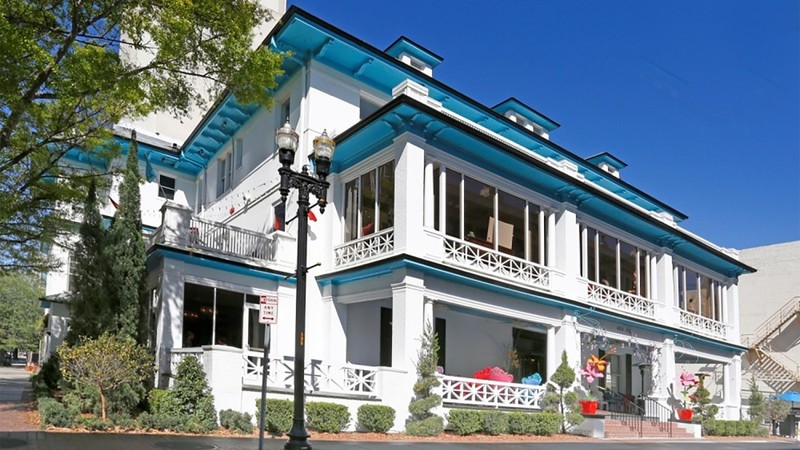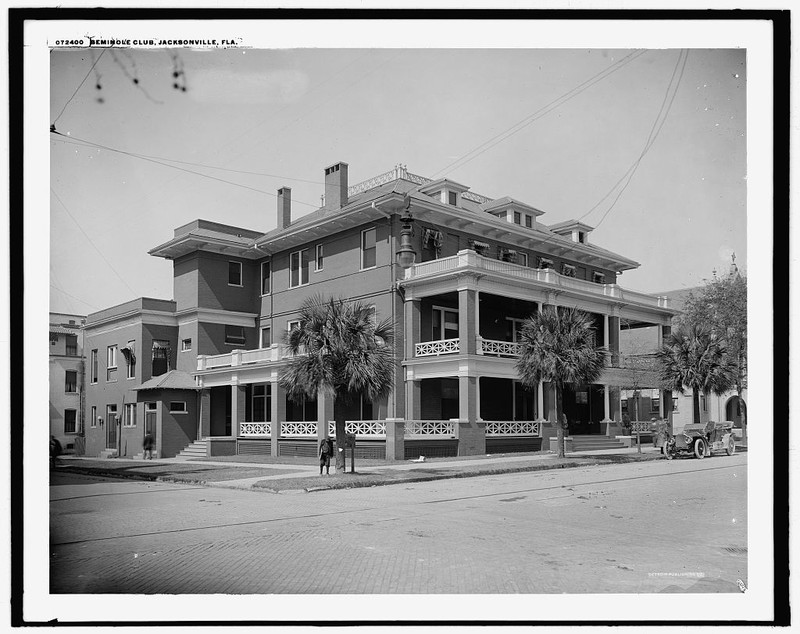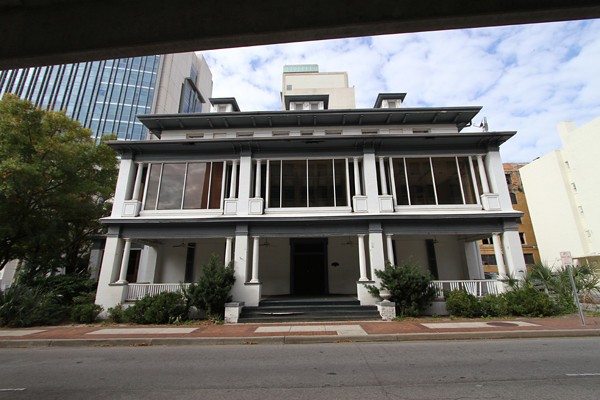Seminole Club/Building
Introduction
Text-to-speech Audio
Images
The Seminole Club in 2019.

The Seminole Club between 1910-1920.

The Seminole Club after renovation.

Backstory and Context
Text-to-speech Audio
In April of 1903, members of the Seminole Club purchased the location on Hogan Street in Jacksonville, Florida, to operate as a prestigious men's club for elite business deals and parties. Appropriating the name of the Seminole tribe, the exclusive men's club operated from this location until its closing nearly 90 years later. Demonstrating change over time, the club that once held such influence over the social, political, and economic life of the city declined in the final decades of the 20th century. Whereas this was once the location of private dinners and meetings that shaped the political and economic life of the city, the building is now home to a specialty candy maker.
The Seminole Club was founded in 1887 on or around St. Patrick’s Day, at a time when many cities across the nation in the late 19th and early 20th centuries were establishing similar clubs. Its purpose was to be a men’s social club where they could conduct business over lunch and secure business deals, often with brandy and cigars. Upon the club’s establishment in 1887, “a few gentlemen” initially met at the Law Exchange Building, according to newspaper accounts from the time. It was Jacksonville’s oldest social club for men and the seventh-oldest in the country. Several years after renting space at the Law Exchange Building, the club occupied a building located on 11 East Forsyth Street. However, soon after claiming the space as their first building to be exclusively occupied by the Seminole Club, it burned down in the Main Street Fire of 1891. Afterward, they moved to a property on North Main Street, but again, that structure was lost to fire in the Great Fire of 1901 that burned most of downtown Jacksonville. In 1903, the club purchased the property on Hogan Street, which was built the year prior.
The structure that housed the Seminole Club was built in 1902 in the Prairie School Style by Rutledge Holmes and Arthur Gilkes. The style was popular in Jacksonville for the first two decades of the 20th century, with Frank Lloyd Wright acting as the leading proponent of the style. The Prairie School Style is known for low-pitched roofs with wide overhanging eaves, as well as strong horizontal lines and flowing internal spaces. The 22,000-square-foot location on Hogan Street that housed the club was originally built as a two-story house with a rooftop garden. In 1907, additions were made by the same architects to create a third story which provided 15 rooms for bachelor residents. In addition to being a place for business and bachelors, it contained handball, racquetball, and basketball courts.
The Seminole Club became so popular that at one point, around 1,000 names were on the club’s membership roster. It included local figures in business, politics, and law, with judges being given their own designated tables inside the club. It was also a location visited by famous figures. Theodore Roosevelt once gave a campaign speech from the upper balcony and when President John F. Kennedy was a senator, he had coffee at the club after campaigning in the nearby Hemming Park. It was also visited by people such as Governor Napoleon Bonaparte Broward and President Dwight “Ike” Eisenhower. In 1988, 101 years after the club’s establishment, women were finally permitted to join the club when Nancy Seely, the daughter of Lou Ritter, the club’s past president, was allowed to join. Until that time, they were permitted inside the club, but not as members, and only on the first floor. By this time the club and its members no longer exercised the kind of social control that led to membership being so coveted. With business deals and networking happening outside of exclusive social clubs, membership declined and the building was closed and eventually turned into a modern sweets shop.
In 1975, Ted Pappas, a local architect, completed a renovation of the club that included adding elevators, which totaled a cost of $1 million. Declining membership reflected changes in society and led to the club’s closure around 1990. In 1998, Restitution Inc., a group of local investors, reopened the club, with several restaurants leasing the building. However, it closed permanently in 2004. In 2006, the building was designated as a historic structure by the city. The same year, it was purchased by Chris Hionides, who then turned it over to the bank in 2011.
In 2014, billionaire Marcus Lemonis purchased the property for $550,000 and he, along with a local candy maker and national television show, worked together to relocate Sweet Pete’s from Springfield into the building of the Seminole Club. River City Contractors assisted with a historic renovation, which consisted of removing rotted wood, rebuilding a corner of the front and side porches, moving and adding walls, bringing the structure up to code, and converting the basketball court into a candy production area. In the process, a safe was found that weighed several hundred pounds, and because of its difficulty to move, contractors initially attempted to paint over it. Work was completed around December of that year, with Sweet Pete’s opening next to The Candy Apple Café & Cocktails restaurant. For their renovation, the owners of the contracting company, Alan and Ellen Cottrill, won the Northeast Florida Builder’s Association Remodelers Council Award. Sweet Pete’s remains in the location today.
Sources
- Downtown Jacksonville Historic Building Self-Guided Tour, Amazon AWS. Accessed October 29th 2020. http://s3.amazonaws.com/visitjax-2018/craft-images/CVB18-025315-HistoricBuildingWalkingTour_SINGLES_NoBleed_m2.pdf.
- Abandoned Jacksonville: Seminole Club, Metro Jacksonville. March 13th 2014. Accessed October 29th 2020. https://www.metrojacksonville.com/article/2014-mar-abandoned-jacksonville-seminole-club.
- Taylor, Jr., George Lansing. Seminole Club, Jacksonville, FL, University of North Florida. December 23rd 2009. Accessed October 29th 2020. https://digitalcommons.unf.edu/historical_architecture_main/704/.
- Seminole Club - Jacksonville, Florida, Florida Memory. Accessed October 29th 2020. https://www.floridamemory.com/items/show/159199.
- Marbut, Max. What's the story on that old house?, Jacksonville Daily Record. May 31st 2010. Accessed October 29th 2020. https://www.jaxdailyrecord.com/article/whats-story-old-house.
- Hawkins, Carole. Renovation of Seminole Club has drawn national attention, Jacksonville Daily Record. January 22nd 2015. Accessed October 29th 2020. https://www.jaxdailyrecord.com/article/renovation-seminole-club-has-drawn-national-attention.
- Seminole Club, Jacksonville, Fla., Library of Congress. Accessed October 29th 2020. https://www.loc.gov/item/2016815717/.
- National Register of Historic Places Continuation Sheet , National Park Service. May 2nd 2016. Accessed October 29th 2020. https://www.nps.gov/nr/feature/places/pdfs/16000212.pdf.
https://www.loopnet.com/learn/want-a-deal-with-the-profit-marcus-lemonis-has-property-to-sell/974909391/
https://www.loc.gov/item/2016815717/
https://www.metrojacksonville.com/article/2014-mar-abandoned-jacksonville-seminole-club
